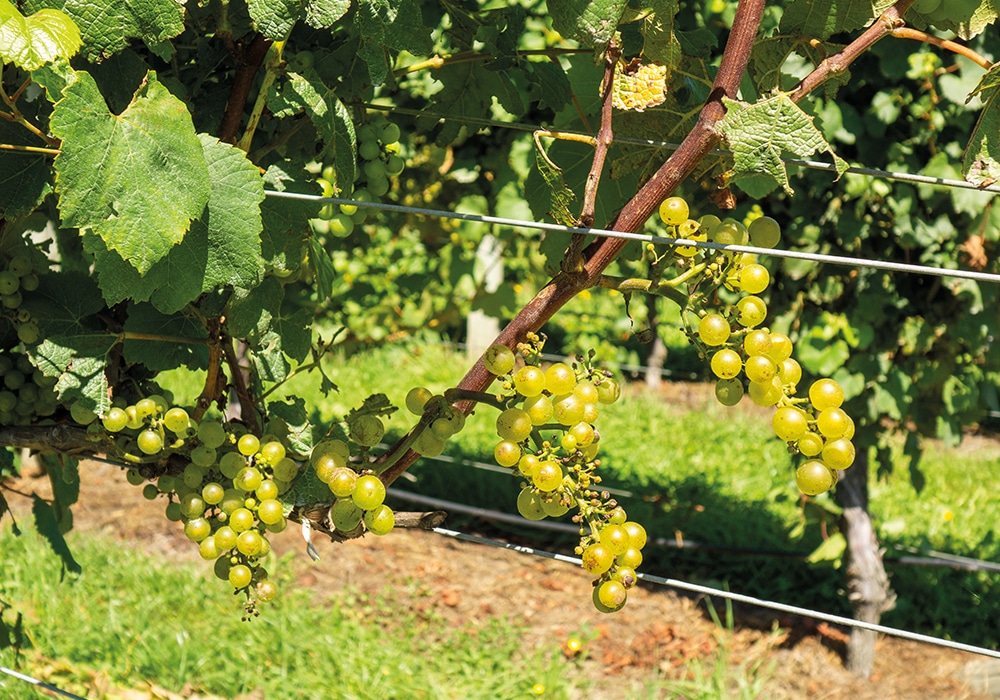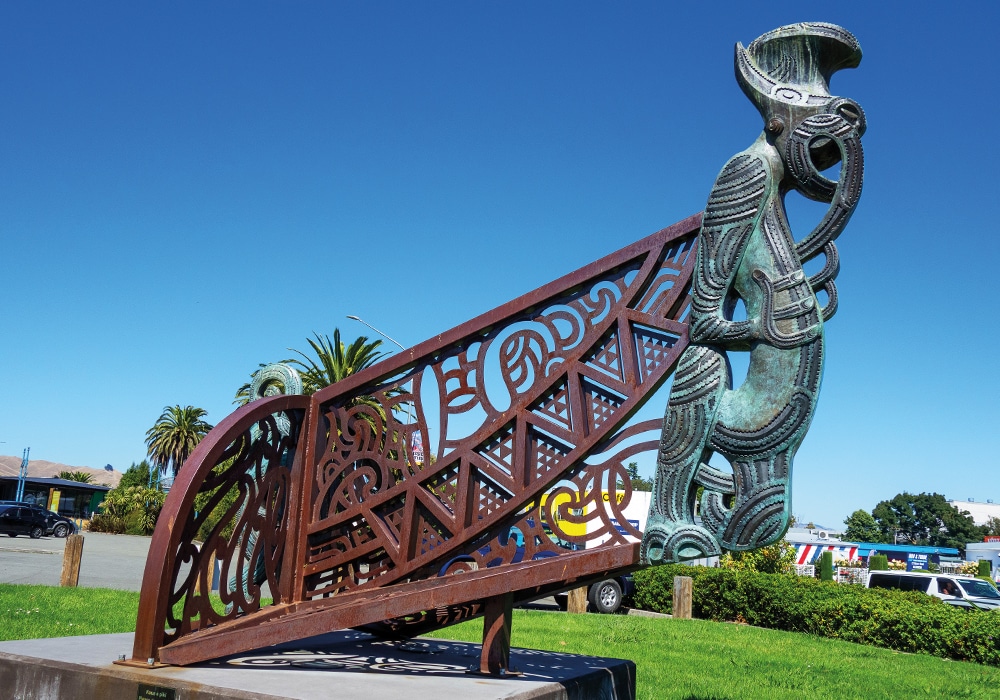Paul Owen discovers that this picturesque land of plenty has a bloody past and a glittering future.
The entrance to Blenheim’s railway station pretty much sums up the epicurean attractions of the Marlborough region. The sign above one side of the doorway reads ‘Wine Station’ while the other calls the building ‘Chocolate Station’. It suggests that Willy Wonka and the Roman god of fermented grape juice, Bacchus, are the spiritual guardians of the town and the fertile river plain that surrounds it.

Blenheim wasn’t always the benign sun- kissed settlement that you find today, with its tempting offers of relaxing bicycle tours of the wineries and chocolateries located just a few thousand pedal strokes away from the centre of the town. It took two grossly violent 19th century events to form the economic foundations of the town’s present bacchanalian economy. Blood flowed freely in the first, while the second flooded the plain with a thick sludge of liquefaction.
When the latter dried out it won a new fertility for the Wairau River valley, and when the flinty soil got covered with myriad sheep droppings during the valley’s 150 years of sheep farming, they added a special richness. By the 1980s, the transformation of the Wairau valley into a world-renowned wine region was moving at a feverish pace. For the Wairau had recently become recognised as one of the best places to grow cold-climate grape varieties in the world. The global success of the wineries would establish Marlborough-grown Sauvignon Blanc as one of the most iconic white wines ever produced, it’s flavour readily identified by gooseberry after-notes and high acidity, both products of the distinctive terroir of the Wairau Valley.

Te Rauparaha versus Wakefield
It’s debatable whether any of the above would have happened without the blood spilled in 1843 in what is now called the Wairau Incident. Twenty-two Europeans and four Māori were slain in a sudden clash to the north of Blenheim when a misguided party of European settlers and militia attempted to arrest two Ngāti Toa Rangatira, Te Rauparaha and Te Rangiheata. The charge was arson, after Ngāti Toa had pulled out the survey pegs illegally planted on their land by the New Zealand Company under the orders of Arthur Wakefield and had burnt them along with the rudimentary huts of the surveyors (the Pākehā were allowed to collect their tools and belongings first).
When the Nelson chief constable, Henry Thompson, attempted to put Te Rauparaha in handcuffs, a shot came from the European side that instantly killed Te Rongo, principal wife of Te Rangiheata. A confused affray followed in which 13 Europeans were killed along with a handful of Māori. Eventually, most of the surviving Europeans were surrounded and forced to surrender. Te Rangiheata got the permission of Te Rauparaha to take utu for the death of Te Rongo, and he dispatched the nine prisoners, including Thompson and Arthur Wakefield, with swift blows of his mere. It was this act of revenge that would lead to the dispossession of all Wairau land held by Ngāti Toa.
For although the Governor of New Zealand at the time of the incident, Robert Fitzroy, ruled that Ngāti Toa had been provoked and could not be held responsible for the deaths, his replacement, George Grey, would use what settlers were calling a ‘massacre’ to deprive the iwi of its leadership. Te Rauparaha was arrested and confined; Te Rangiheata hunted into exile. Without these Rangatira present, junior Ngāti Toa chiefs were then persuaded by Grey to sell the iwi’s land at both Porirua and Wairau to the British Crown. Grey cunningly pleaded “give me the land where my dead died”, appealing to the spiritual importance of utu to Māori. The iwi relinquished more than 250,000 acres in the interest of keeping the peace, much of which was then sold on by the crown to the New Zealand Company.
The big shake
Tuamarina (a Pākehā construct of the Māori name Tua marino), where the incident took place, was one of the first places in the Wairau to be settled by Europeans after the Ngāti Toa sale went through in 1847. However, eight years later in 1855, a violent earthquake measuring 8.2 on the Richter scale would tip settlers’ preferences in favour of Blenheim. For the big shake widened the Ōpaoa river, enabling navigation where the braided Wairau near Tuamarina permitted none. Blenheim, named after the 1704 battle in Germany, where the First Duke of Marlborough, John Churchill, defeated a combined French and Bavarian force, would get its start as the most viable port of the new province.
The earthquake gave Blenheim another boost. The shake brought hillsides crashing into the valley and lakes of silty liquefaction surged to the surface, covering the original soil full of river stones and rocks. After the settlers rebuilt their fences and buildings, they found that the grass in their paddocks grew abundantly as a thick layer of fine silt now formed the topsoil, enabling richer pastures. With scows now able to sail up the river to the centre of the town to collect the wool clip, Blenheim quickly grew to become the capital of Marlborough in 1865. It would transform into New Zealand’s wine capital a little over a century later, the 70 wineries located nearby producing 70 percent of the country’s wine.

Follow your nose
From the station, you’ll find the Ōpaoa river a few frantic steps away after crossing busy SH1. It’s a far quieter stroll down by the water and there’s a walkway/cycleway tracing the river as it runs through the town to its confluence with the Taylor River. For even more peace, Pollard Park, full of natural woodland, is a 30-minute stroll away, while Seymour Square with its roses and 1920s war memorial clocktower is even closer. The square is named after early settler, Henry Seymour, who held the title to the land the town was built on back in the days when Blenheim was called Beaverton because of frequent flooding. From 1857 onwards, the now well- manicured square was casually used by the public to graze their animals, a practice that was eventually prohibited in 1880.
There’s a wide range of cafés and restaurants to be found in the park-fringed centre of Blenheim, offering everything from supposedly world-famous pies to fine dining. It’s best to top on the calories there if you’re contemplating a tour of the many wineries and chocolateries of the town’s hinterland by bicycle.

Frank’s big gamble
It was one of the founding brothers of Titirangi-based Montana Wines, Frank Yukich, who first took a big punt on 1600 hectares of Wairau Valley farmland in 1973 on the advice of DSIR scientist, Wayne Thomas, who had recognised the area’s potential to produce fine cold-climate wines – Sauvignon Blanc, Chardonnay, Pinot Noir, and aromatics.
Frank paid the deposit on nine farms out of his own pocket, certain that the Montana board would eventually approve the purchase (they did). The land agent, John Marris, would later recall that Frank bought the nine farms in 10 days and that the land values in the Wairau Valley virtually doubled overnight from $250 per acre to $500 once word of Montana’s investment spread through the farming community. John Marris would go on to establish Wither Hills on the southern edge of the valley with his son, Brent.
By the time Ernie Hunter bought his 26-hectare block to establish Hunter Wines in 1979, he paid $3000 per hectare, twice the going rate at the time. Such was the quality of the terroir at Hunter’s new block in Raupara near the Wairua river on the northern side of the valley for cold- climate wine grapes, Hunter would win the gold award at the Sunday Times (U.K.) Vintage Festival over three consecutive years – ’86, ’87 and ’88. This success and the impact of trend- establishing Marlborough winery Cloudy Bay on the export market from 1986 onwards did much to enhance the global reputation of the region.


A family affair
A self-guided wine trail tour by bicycle in Marlborough usually costs $50 and includes pick-up/drop-off at your accommodation, bike and safety gear hire, and a map of the trail that shows the safest routes. You’ll need to pay for the tasting fees charged along the way and for your lunch (your own packed picnic is sometimes a nicer alternative). It’s therefore best to think about which establishments you wish to visit before setting off. Do you want to visit chocolateries like Makana Confections as well? Do you want to visit large corporate wineries or small family-run businesses?
If the answer is the latter, Bladen Wines on Framington Road, west of Renwick, is a great choice. Established by Dave and Christine Macdonald in 1989, the brand is an amalgam of the names of their two children, Blair and Deni, who were toddlers when the grapes were first planted. It’s Blair who’s on deck at the cellar door when MCD calls in, giving his usual lively spiel about a label that bears an image of his mum’s pruning gloves and how the winery ‘hand-crafts’ the wine it makes. It’s an engaging performance that might have been acknowledged by the unnamed Wine Personality of the Year trophy nestled in a corner of the cellar.

The flying circus
No Marlborough wine trail tour is complete without a visit to Omaka airfield, a few kilometres away from Wither Hills, and the home of the Omaka Aviation Heritage Centre. Thanks to the input of Sir Peter Jackson, WingNut Films and Weta Workshop, the OAHC is chock full of historic military aircraft from both world wars displayed in creative ways that tell their heroic stories in vivid detail. There’s even the WWI uniform of Herman Goering on display, showing him to be a bit physically smaller in the days when he won the ‘Blue Max’ medal as a fighter ace. It’s details like these that make the OAHC such an absorbing place, so reserve at least a couple of hours for your visit.
The adjacent airfield and its workshops are no less fascinating, and if you’re feeling adventurous you can go for a joy ride in either a Boeing Stearman biplane, which seats two passengers up front and the pilot at the rear, or a Russian Yakolev Yak-3 WW2 fighter powered by a mighty Allison V12 engine and capable of 600kmh. The workshops are full of WW1 and WW2 aircraft in the process of restoration, including some of the 295 Curtis P-40 Warhawk fighters that the RNZAF flew with elan during WW2. A visit to Omaka makes a climactic finish to any tour of Blenheim and its environs.









